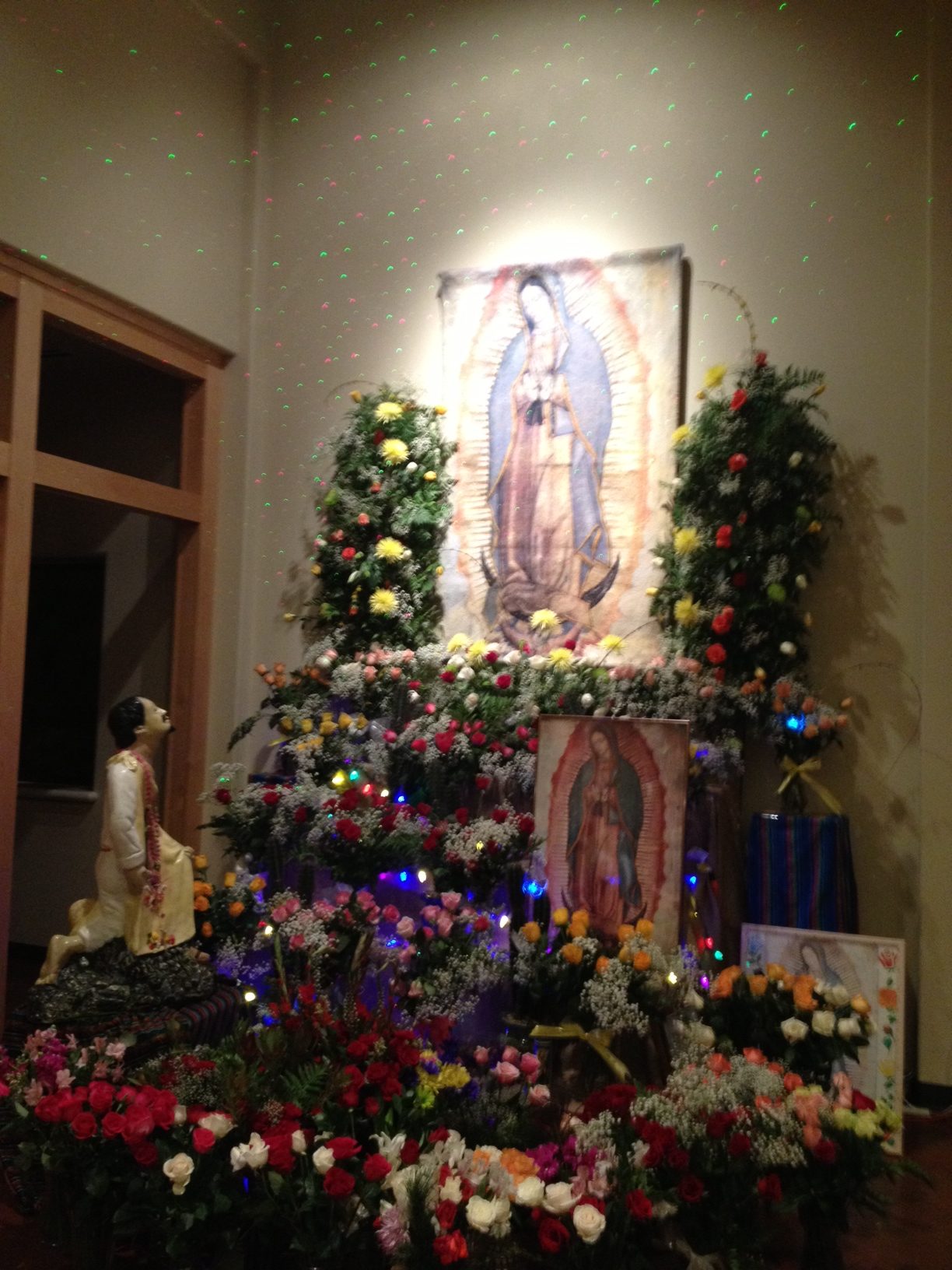Aztec dancers whirled, while drums beat and a guitar-backed chorus sang Spanish hymns in praise of La Senora de Guadalupe. The pre-dawn celebration honors Mexico’s patron saint, and even in frozen Alaska, the tradition warms up a December morning.

It’s 4 a.m. on December 12, a day which is important to Mexicans around the world. It’s the feast day of the Virgin of Guadalupe, and in Anchorage, where near-zero temperatures and frozen fog have covered the trees outside with fluffy hoar frost, musicians and dancers are gathering inside a warm church to set the stage for a very, very early celebration in honor of the day.
Norma Wadsworth was born in Mexico, but she lives in Alaska and is a member of the congregation. She said it’s a typical Mexican tradition to serenade loved ones at dawn.
“We serenade early in the morning on your birthday,” Wadsworth said. “And that’s why we serenaded the Virgin of Guadalupe, because December the twelfth is her day.”
The ceremony is called Las Mañanitas, but in this case, the songs are not romantic ballads but hymns to the Virgin.
A hundred or so people have gathered in the church vestibule, and promptly at 5 am, the faithful enter the church in a long procession, singing a song to the Virgin of Guadalupe.
“Las Mañanitas is a very unique song,” Wadsworth said. “In this particular case the mañanitas are made especially for our Virgin of Guadalupe, which in Mexico we call the Virgin Morena. Morena means we are a little bit darker, because we Mexicans are a little bit darker sometimes, because we have different skins. But mainly, we are Indians, and we are very proud to be. And we are a little bit darker in skin, and that is why she is our Virgin Morena.”
The crowd proceeds to gather before the special shrine inside the church, depicting Juan Diego and his apparition of the Virgin Mary.
Mexico blends Spanish and Aztec culture, so the story of Juan Diego and the vision of the Virgin has terrific cultural significance for Mexicans.

So, who was Juan Diego?
“Juan Diego was the one that the Virgin of Guadalupe chose to speak to him,” Wadsworth explained. “To let him know that she wanted to have a church made in her name. And that’s why she chose him to be the person to give the message to the church people.”
The story goes back to 1531. Legend has it that an Indian farmer, Juan Diego, was walking near his village of Tepeyac when he was startled by a woman’s voice. He saw her, golden light glowed around her, and she spoke in Nahuati, the Native tongue.
The Virgin asked Juan Diego to build a church on the site of an Aztec temple. He told the local Catholic archbishop about his encounter, but was not believed. The archbishop wanted more proof.
So Juan Diego went back to the site, and spoke to the Lady again. She directed him to pick the roses which had suddenly sprung up in the desert, a miracle in December. She told him to gather up the roses in his poncho
“And he did,” Wadsworth said. “When he showed it to the bishop, he said ‘Did you bring me what I asked you?’ And he said yes and when he spread his tilma or poncho, he spread it out, and when the different roses came out, and at the same time, the emblem, the Lady of Guadalupe, was pressed in the tilma.”
When the roses tumbled out of the mantle, an image of the Lady remained on the fabric.
The red and white roses are a symbol of the Lady of Guadalupe.
This December 12, fresh roses of all colors filled a shrine to the Lady inside the aptly named La Senora de Guadalupe Catholic church in Anchorage. The procession halts in front of the shrine, and the guitarists strikes up a tune.
As a narrator read the story, young dancers dressed resplendently in glittering fabrics and elaborate feathered headdresses, enter the church and dance before the shrine to the Virgin. The rhythm of the rattles and hand drums fills the church, as they twirl and turn.
Today, there is a church on Tepeyac Hill, the Basilica of Santa Maria de Guadalupe in Mexico City. Juan Diego’s mantle is still there, too. It’s called a tilma in the Native language and made of cactus fiber. It should have disintegrated long ago, but it didn’t and the image is still on it.
It’s that image that is instantly recognizable – of a woman wearing a star-covered blue cloak surrounded by brilliant gold rays. It’s a powerful image of Mexican nationality. Every December 12, thousands gather in Mexico City to honor the country’s special saint.
But here in Anchorage, the celebration is no less fervent.
Wadsworth said women of the congregation made all the costumes and teach the dances. She said the crowd of celebrants grows larger every year.
APTI Reporter-Producer Ellen Lockyer started her radio career in the late 1980s, after a stint at bush Alaska weekly newspapers, the Copper Valley Views and the Cordova Times. When the Exxon Valdez ran aground in Prince William Sound, Valdez Public Radio station KCHU needed a reporter, and Ellen picked up the microphone.
Since then, she has literally traveled the length of the state, from Attu to Eagle and from Barrow to Juneau, covering Alaska stories on the ground for the AK show, Alaska News Nightly, the Alaska Morning News and for Anchorage public radio station, KSKA
elockyer (at) alaskapublic (dot) org | 907.550.8446 | About Ellen




